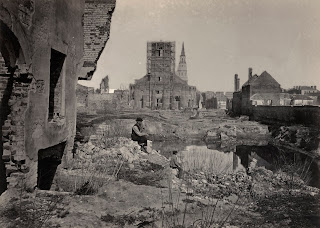What could have been is not in this book which is about as dull and lifeless as the September 11 Memorial at the Pentagon.
For a layperson, a good chunk of The Girls of Atomic City: The Untold Story of the Women Who Helped Win World War II by Denise Kiernan is about as compelling as a manual on neutrons splitting, "liquid thermal diffusion" or "concentric vertical pipes" which actually fill up every other chapter with descriptions about the development of the atom bomb. Yawn. Once I figured out the pattern I skipped about a third of those confounded interruptions (they got more interesting) and moved on since a nuclear scientist I ain't.
Even with a character list in the front, the women who are the subjects are too many and varied to keep straight. Who did what and with whom? And what was her background?
An improvement would have been a biographical sketch of each woman separately, rather than assembling all the players together in one jumbled heap, chapter after chapter.
Another flaw are the tenses: present tense, past tense, and past progressive tense, as in far too many "was's." "Was" this, "was" that. (I "was tense." Just kidding.) I couldn't help but think that in the hands of a more skillful writer or editor, the story would have been vastly more absorbing. But you must catch my drift by now.
Were they happy with the end product when they learned what it was after it was dropped on Hiroshima on August 6, 1945? Not really. No one ran around slapping high-fives or drinking champagne.
Rather than the main characters, the true horror story threaded throughout the book is the history of the development of the town with no name which the governor of Tennessee didn't even know existed until a year after the place got started in 1942. (It was called “Clinton Engineer Works” for short before it was christened Oak Ridge in 1949.)
Practically none of the thousands of new employees knew what anyone else was doing, or what they were working towards or building, and, as a matter of fact, they didn't even know what they were working on since everything was "hush, hush." Asking questions would certainly raise suspicions. After all, it was the "Secret City" where everyone was sworn to secrecy, except for enlisted "snitches."
About all that was “publicly” known was they had accepted jobs in an undeveloped new town in Tennessee, which drew employees from various parts of the U.S., to work at who knows what in a mud mess of a place filled with quickly constructed "hutments" (defined by Wikipedia as "one room shacks") which passed for living accommodations for those less fortunate.
The employees socialized whenever possible, despite efforts by the government to keep them quiet and harnessed. That way, communication between employees was kept at a minimum. As for blacks, married black couples were not permitted to live together nor could they swim in the pool. Or attend the schools. (They were sent to nearby Knoxville.)
Have there been any studies on comparative cancer rates among Oak Ridge employees who lived and worked on the bomb? Just asking.
You think Hitler only practiced in Europe? Seems like the U.S. military got hold of his playbook early, to wit:
Any "creep" could report anyone anonymously for "sedition," and based on one person's account, the reported employee and his or her family could be thrown out of Oak Ridge within 24 hours. Pay your own way back to wherever you came from, please. (Okay, so they weren't murdered a la Hitler. Please read on.)
Why not test the effects of deadly plutonium on humans by injecting it into an unsuspecting black man without his consent, an automobile accident victim with broken bones? Why bother to get consent? And why not wait 20 days to set his broken bones to check on plutonium's effects upon broken bones? Great idea! And while you're at it, why not extract some of his teeth without his permission, like about 15 of them, and ship them to New Mexico to find out what plutonium does to teeth.? Oh, and then have the subject, labeled HP-12 (real name: Ebb Cade) "conveniently" disappear and die at age 61?
Yes and why not administer electroshock to an employee who talks too much? And place him in solitary confinement, too, for good measure? That'll show the rest of 'em to keep their mouths shut!
There once was an couple in Oak Ridge who went parking (click here for a definition), and a stranger poked his head in the car window while said couple was parked on a lonely road and called out the woman's name. At work the next day, the man's boss approached the woman and ordered her not to see the man any more. Don't worry! I want to keep my teeth!
During the 1940s my ex-father-in-law, whom I never met, was an engineer at Oak Ridge who died mysteriously one night while at work. He was 37. His superiors said he died of a "heart attack" which the coroner confirmed. Do you think a coroner back then (and what about now?) would reject the military's pronounced cause of death?
Over the years I've urged my children to exhume their grandfather's body and find out if a "heart attack" was the cause of his death. Early heart attacks then and now are not part of his family's history. Except for his.
Correction on page 277: It was not Kingston which was/is the site of Tennessee Eastman's main operations, but Kingsport, where I graduated high school.
patricialesli@gmail.com
patricialesli@gmail.com








 George N. Barnard, Ruins In Charleston, South Carolina, 1865, The Nelson-Atkins Museum of Art, Kansas City, Missouri. Gift of Hallmark Cards, Inc./Michael Lamy
George N. Barnard, Ruins In Charleston, South Carolina, 1865, The Nelson-Atkins Museum of Art, Kansas City, Missouri. Gift of Hallmark Cards, Inc./Michael Lamy



































